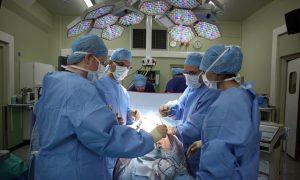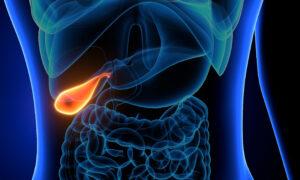Most everyone looks forward to a bit of indulgence when holiday meals roll around. Yet for a percentage of the population, discomfort hits about 20 minutes into dinner, and they end up seeing a gastroenterologist within days.
It’s a trend that Dr. Daniel Davila, a gastrointestinal surgeon at Northwestern University Feinberg School of Medicine, sees every year, starting after Thanksgiving.
“Usually, this is related to gallstone disease, which is not uncommon, particularly in the American population. Gallstone disease is often precipitated by fatty meal exposure,” he told The Epoch Times. “Especially after Thanksgiving, it’s not uncommon for us to see patients coming in to see us because the Thanksgiving meal, which often is fatty, has precipitated either new or worsening symptoms related to gallstones.”
Bile—composed mostly of cholesterol, bile salts, and bilirubin—is actually made by the liver. It’s held in the gallbladder until the body signals to empty into bile ducts leading to the duodenum, the entry to the small intestine.
“Certain cells in the small bowel detect a fatty meal, and send a hormone to the gallbladder to secrete more bile,” Dr. Davila said. “Sometimes, the stones are there, and it causes them to become symptomatic and painful for patients.”
Excruciating Pain
Gallbladder attacks often will last about three to seven hours once the pain first begins, Dr. Davila said. When the pain recedes, that usually means the stones have dislodged themselves.“For people whose pain persists and lasts for seven hours ... those stones may not be clearing and they may need to go to the emergency room to be evaluated,” he said. “It really can happen to anyone. Often, they don’t even know they have gallstones.”
About 25 million people in the United States have gallstones, according to the National Institute of Diabetes and Digestive and Kidney Diseases. It affects up to 15 percent of the population. About 1 million people are diagnosed with gallstones annually, with about 25 percent being treated, typically with surgery.
Living Without a Gallbladder
Because you can live without a gallbladder, cholecystectomy—surgery common for problematic gallstones—isn’t considered a risk to overall health and quality of life. Your liver still produces the necessary bile. But it may not make enough to aid in the digestion of large or fat-heavy meals.“You don’t get that burst [of bile] at meal time and can’t make enough to store. You can’t eat certain foods because it upsets the stomach,” Ms. Shapson said. “Then, it becomes a food restriction thing. When you don’t have a gallbladder, you’ll most likely suffer from constipation.”
Saving Gallbladders
Newer research is challenging the knee-jerk reaction of removing gallbladders because of pain and stones. A study published in The Lancet in 2019 concluded that certain patient groups don’t benefit from gallbladder removal.Over three years, 1,067 patients were analyzed: 537 were given “usual care” and 530 were assigned to a “restrictive strategy” that reserved surgery. Patients were followed for a year, and 56 percent were pain-free in the restrictive group, compared to 60 percent in usual care. Additionally, the restrictive group had 358 cholecystectomies, compared to 404 in the usual care group.
Surgery isn’t the only treatment for stones, but ursodiol, the medicine used to break them up, can take months or years of treatment. Lithotripsy, using shock waves to break gallstones into smaller pieces, is rarely used—usually in conjunction with ursodiol.
Ms. Shapson also helps patients who want to avoid having their gallbladder removed with various supplements and lifestyle changes.
“You can save every gallbladder, even if it’s sludgy and full of stones and really backed up,” Ms. Shapson said. “People can get ahead of it when they start to feel discomfort in that lower right rib cage area. If you start soon enough, you can catch it before you’re in that place of excruciating pain.”
- Drinking warm water with lemon in the morning to stimulate the digestive system.
- Taking digestive enzymes.
- Consuming bitters, such as arugula, before each meal.
- Eating beets, which are associated with better bile flow.
- Drinking adequate water.
- Eating quality fat.
At Epoch Health, we’ve handpicked our partner, Heritage Formulations who produces Digestive Enzyme supplements here in the USA. Now, it’s simpler than ever to prioritize your health while staying true to your values.
Weight Is Also a Factor
The National Institute of Health also recommends eating fewer refined carbohydrates and less sugar and eating more foods high in fiber. It’s also important to lose weight in a way that’s healthy. Obesity is associated with gallbladder disease.“Whether it’s related to diet or not, it’s hard to say. What’s interesting, especially in the world of these new diet medications, is we found that even weight loss is also associated with an increased likelihood of gallstones,” Dr. Davila said. “We’ve definitely seen that in that population in the past who either lost weight intentionally quickly or had surgery and lost weight.”
That connection could be hormonal or related to changes in metabolism, he said. Being healthy in general is protective, as well as lowering stress—which can turn off mechanisms associated with digestive problems. Unfortunately, once gallstone pain begins, there’s nothing that can alleviate it except time.
“Try to stay healthy with all meals, not just Thanksgiving,“ Dr. Davila said. ”Whether you have gallstones or not, especially during Thanksgiving when the meals tend to be a little fattier, take your time.”






